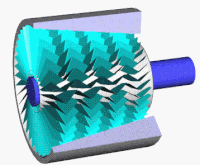
Photo from wikipedia
Developments in materials, manufacturing and computing methods have catalysed the generation of efficient compressor designs with higher specific power outputs. Centrifugal compressors have become pervasive in environments demanding a combination… Click to show full abstract
Developments in materials, manufacturing and computing methods have catalysed the generation of efficient compressor designs with higher specific power outputs. Centrifugal compressors have become pervasive in environments demanding a combination of higher power with smaller sizes such as unmanned aerial vehicles, micro gas turbines and turbochargers. These compressors are expected to perform optimally in a range of operational speeds and mass flow states with low acoustic emissions. The impact of operating speed on the flow and acoustic characteristics of a ported shroud compressor has been explored in this work. The operation of the open and blocked configurations of the compressor at the design and near surge points each of a lower and a higher speedline was numerically and experimentally investigated. Comparing the results, the model was shown to predict the operation of the compressor for both configurations at the investigated operating points satisfactorily in terms of both performance and dominant acoustic features. With an increase in the velocity and the Mach number due to increased operational speed, changes in the flow behaviour in the inducer and diffuser were observed. An increase in operational speed was shown to generally increase the overall acoustic emission of the compressor for both configurations. The number of distinct tones in the acoustic output and their magnitude were also seen to be a function of operating speed.
Journal Title: International Journal of Engine Research
Year Published: 2020
Link to full text (if available)
Share on Social Media: Sign Up to like & get
recommendations!